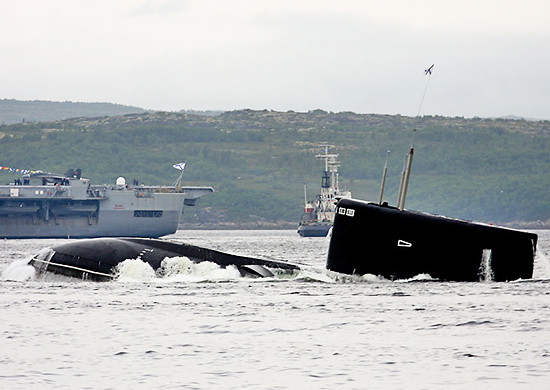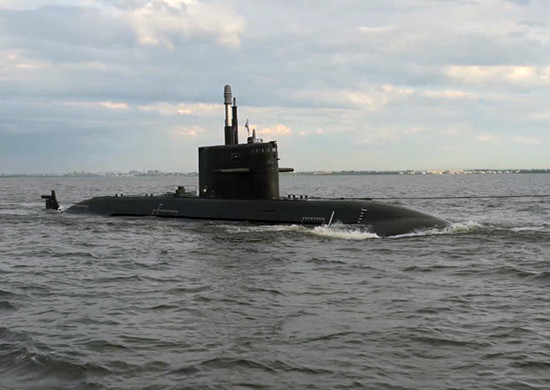President of the United Shipbuilding Corporation (USC), Alexei Rakhmanov, said that in the near future, Russian specialists will create a marine prototype of an air-independent (anaerobic) power plant (VNEU) for the fifth-generation submarine Kalina. Also, this power unit will be equipped with part of the fourth generation submarines of the project 667 "Lada".
Research work on the VNEU was completed in 2014. In 2016, the designers conducted a cycle of its ground tests, and at the beginning of this year they tested a mock-up of a gas turbine engine. Three St. Petersburg enterprises are engaged in the development of the power unit: Rubin Central Design Bureau, Malakhit Design Bureau and Krylov State Research Center (KGNTs).
VNEU eliminates a significant drawback of modern non-nuclear submarines. It lies in the fact that diesel-electric submarines have to float quite often to replenish the battery charge. Thus, enemy aircraft can easily detect the boat. Anaerobic installation allows the boat to be under water from 20 to 45 days.
“In non-nuclear submarines, diesel acts as a power generator for electric motors. However, a diesel engine cannot operate without in-flight air, or rather oxygen. Therefore, diesel-electric submarines are forced to emerge daily or in a few days, ”Dmitry Kornev, the founder of Military Russia, explained in an interview with RT.
According to the expert, the classic diesel-electric submarine is not able to move at high speeds for a long time and escape from modern means of observation. Rising to the surface, the submarine almost always gives the enemy the opportunity to detect it.
Diesel Hydrogen
The development of VNEU started in the 1950s in the countries of the West, and a little later - in the USSR. Scientific and technical research focused around exploring the capabilities of air-independent "Stirling engines" (a type of external combustion engine. - RT ).
However, for several decades, scientists could not achieve practical results because of the complexity and high cost of operating such units. In the late 1980s, Swedish specialists achieved success, creating a first submarine with an efficiently operating VNEU.
In the 1990s, the Kockums Submarine System concern built three small submarines of the Gotland type, equipped with anaerobic installations. However, their mass production was not developed. In 2000, the German Navy and the Self-Defense Forces of Japan acquired an air-independent engine.

- Russian submarine ascent
- © function.mil.ru
Kornev suggests that the Russian VNEU can surpass foreign analogues. In particular, to generate electricity, the domestic anaerobic plant uses highly purified hydrogen, which is produced from diesel fuel. At the same time, overseas reserves of hydrogen are loaded aboard submarines before going to sea.
At the Army-2017 forum, the Central Research Institute of Ship Electrical Engineering and Technology (part of the KGNC) presented a sample of a battery based on solid fuel elements BTE-50K-E. This battery is one of the most important elements of VNEU. The battery is part of the power modules with a capacity of 250-450 kW.
“In recent years, batteries have been actively improved, they are becoming more capacious and compact. For example, in the first half of October a boat with lithium-ion batteries was launched in Japan. The Japanese expect that the duration of their stay under water will be comparable to what a VNEU is capable of, ”said Kornev.
At the same time, as the interlocutor of RT noted, it is now difficult to predict how successful the Japanese Navy experiment will be. According to Kornev, with high probability the newest battery samples will be used for a long time to increase the capacity of the VNEU.
"Strategic and multipurpose"
The Russian anaerobic plant is being developed as part of the project for the Kalina non-nuclear submarine. October 16, Alexei Rakhmanov said that the USC is ready to lay the fifth-generation submarine as soon as it receives the corresponding order from the Ministry of Defense.
Earlier, a top manager emphasized that “Kalina” “will be a completely different boat in terms of physical fields”. According to him, it will be "strategic and multi-purpose for a number of its key elements." It is assumed that the fifth-generation submarine strike armament will be based on the Zircon hypersonic missile system.
Currently, the most modern non-nuclear submarine of the Navy is the project 677 "Lada" developed by TsBB "Rubin". Today, the St. Petersburg submarine is in trial operation, while Kronstadt and Velikie Luki are planned to be transferred to the fleet in 2019 and in 2021, respectively. The construction of two more submarines was laid down in the state armament program (LG) until 2027. The sixth “Lada” should get VNEU.
In a conversation with RT, Doctor of Military Sciences, Captain of the 1st Rank Reserve, Konstantin Sivkov, suggested that the Kalina was being developed on the basis of the Lada, which belongs to the fourth generation of non-nuclear submarines. According to him, today the VNEU is “actually created” and therefore the industry is ready for the production of the latest submarines.
“Information about this project is classified. But surely our designers will take the best of the submarines of previous generations, primarily from the Lada. It will be a low noise and almost imperceptible boat. The appearance in the Navy "Kalina" will fully realize the combat potential of the non-nuclear component of the submarine fleet, "- said Sivkov.

- Project 677 submarine
- © function.mil.ru
Dmitry Kornev said that, most likely, “Kalina” will be quite different from its predecessors. In addition to the anaerobic unit, more advanced batteries and electronic equipment will be installed on the submarine. In terms of dimensions and a number of other characteristics of the submarine will noticeably surpass the "Lada".
“In our country, traditionally built double-hull submarines: in addition to a strong inner hull, they have a light permeable. This design increases survivability in the event of damage, but reduces buoyancy and low noise. It is very likely that Lada will be single-body, and this is an undoubted step forward, ”said Kornev.
The expert believes that the anaerobic installation will allow the newest Russian submarines to perform tasks more efficiently both at shallow depths (in the Black, Baltic, Mediterranean seas) and in the World Ocean. According to Kornev, submarines of the fifth generation, in terms of their combat capabilities, will approach the more expensive and powerful atomic models.
“Of course, it’s unlikely that Kalina will patrol the US coast. But boats from the VNEU may well track the movement of the enemy’s nuclear submarine fleet, ensure our strategic cruisers enter the ocean and carry out a wide range of other combat missions, including the defeat of large surface forces and ground targets, ”concluded Kornev.
